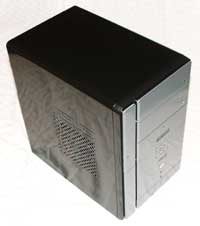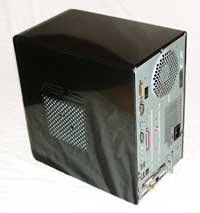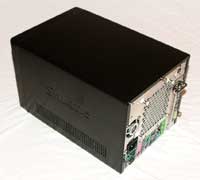Close Encounters of the Small Kind
by Jarred Walton on December 8, 2004 12:05 AM EST- Posted in
- Cases/Cooling/PSUs
Close Encounters
Writing for AnandTech puts me in something of a unique position. Few brick and mortar stores carry a large selection of SFF cases, and looking at pictures online doesn't always tell the whole story. With AnandTech, we have a large number of SFF units, many still waiting to be reviewed. (A SFF roundup will be coming soon, in case you were wondering. This is just a preface to the roundup.) The plan wasn't for me to begin using one of these cases as my own system initially, but system instabilities with one of my own computers caused me to change my mind. While I RMA the motherboard that is apparently causing problems and wait for its return, I decided to adopt one of the SFF cases for my own use - but which one?Understanding that aesthetics are a completely personal view, I checked out all of the cases. They all look pretty good, depending on your own taste - what I hate, someone is bound to love, and what I like, some will think is boring. In the end, I built two of the units just for purposes of a "test drive" and I picked what are basically the two extremes of the SFF genre.
 Click to enlarge. |
 Click to enlarge. |
On the one hand, we have the ASUS T2-P Deluxe. Depending on your point of view, it may not even qualify as a true SFF design. Featuring two CD/DVD slots, a 3.5" floppy bay - the floppy drive is actually included with the case - and an internal 3.5" HDD, not to mention a ton of other extras, the ASUS SFF includes everything and the kitchen sink. (The manual states that a CD/DVD drive is also included, but it was not present in this unit. This is possibly due to the fact that this unit was sent for review purposes, but it could also just be an error in the manual. We will try to get the official word from ASUS for the formal review; for now, it has a spare DVD-ROM in it.) Audio, fast Ethernet, USB2.0 and IEEE 1394a Firewire are pretty much standard features on any SFF. Add to that a six-in-one flash card reader, gigabit Ethernet, a radio tuner and antenna, integrated graphics, 802.11G wireless networking, and even serial and parallel ports, and you have a package that leaves little to be desired in terms of features. ASUS does limit your expansion options in one area, however. Many of the extras are included on a PCI add-in card, so your expansion card options are limited to adding an AGP graphics card.
 Click to enlarge. |
 Click to enlarge. |
The other unit is the latest from Shuttle, the XPC G5. Shuttle has been in this game longer than any other company, and after taking a look at all of the units stacked up, the design of their latest G5 model caught my eye. It's available in a few different formats: socket 775 with an 875P or 915P chipset and socket 939 with the Nforce3 250 Ultra chipset. Shuttle also has many other non-G5 XPC models that are worth checking out. Since the graphics card that would be used was an AGP model, PCI Express and the 915 chipset models were out of consideration. The system won't be used much for gaming, and the GPU would be the limiting factor anyway, so I ended up with the SB77G5 instead of the SN95G5. If I were actually to recommend an XPC model, I would choose the SN95G5 normally, but I wanted to try out a socket 775 system, as I had not yet done so. The features of the SB77G5 are similar to the ASUS T2-P Deluxe, only with less "extras". You get Firewire, USB2.0, Gigabit Ethernet, one 5.25" external bay, one 3.5" external bay, and one 3.5" internal bay. There's a good reason for the lack of extras, of course. The Shuttle XPC G5 is one of the smallest SFF cases out there.










45 Comments
View All Comments
nostriluu - Thursday, December 9, 2004 - link
OK, I realize this is going to get erased as a troll, but its not meant to be one.The first paragraph on this article seems to be trying to clear people's conscience on the issue of e-waste.
Its undeniable that there are huge cycles that are our of our control, but there is also an impact from e-waste that creates minor disasters and disease for people around the world.
Anandtech could try to be a responsible site by acknowledging this factor and encouraging efforts, such as "cradle to grave" enviromental consideration for hazardous(!) material, recyling for needy organizations, encourage vendors to "green" their products (which is already happening) and so on.
Ignoring this issue, or trying to dismiss it, puts Anandtech into a category of conscienceless consumerism that makes the world a worse place to live.
Tech enthusiasm and responsible living can go hand in hand, otherwise you can only consider yourself greedy, and tech enthusiasm becomes a form of putting ones head in the sand.
And yes, individuals are responsible for messes that are created.
PrinceGaz - Thursday, December 9, 2004 - link
#18- "We all run Memtest, of course, so how can we escape the floppy?"They provide bootable ISO CD images you can download and burn, so you don't need a floppy.
Saist - Thursday, December 9, 2004 - link
Just wanted to state that I picked up Solteks EQ3801 and have been quite pleased by the case...What concerns me about SFF units is the power supply... or rather, lackthere of.
archcommus87 - Wednesday, December 8, 2004 - link
Not here.My computer's loud, because I run all four of my fans at top speed to keep temps okay with my 467 MHz overclock. But after awhile you just get used to it and it really doesn't bother me anymore.
JarredWalton - Wednesday, December 8, 2004 - link
20 - Are you listening to them on a Windows machine? I've tried them on three computers (a 1.13 GHz P3, a 2.8C P4, and my own Athlon 64 3200+) and didn't have any issues. They should be relatively quiet, and the quality isn't great but should be sufficient. Anyone else having issues with the WAV files?Avalon - Wednesday, December 8, 2004 - link
All the sound wavs sound extremely distorted, like bombs going off in WW2 :Dsnowman - Wednesday, December 8, 2004 - link
I just posted the following Review on New Egg's site this week. Looks like we're on the same page.Snowman,12/4/2004 7:22:20 AM
I'm a 55 year old Extreme Gamer. I've been building gaming rigs since before it was cool. I build a new box every year and, with my experience, I try to beat Max PC's Dream Machine. My wife gets my old rig. She was OK with it, but she always said they were too big, noisy, lit-up, and intimidating. So I built her one of these for Christmas.
I was concerned that it might be very difficult because I wear a XXL glove size and still can palm a basketball. All I can say is "WOW". The quality is first rate, instructions are easy to understand and the design is superior. I really took my time and had it up and runing with XP Pro w/SP2 installed in under 3 hours. Everything is well thought out and, if you take your time, goes together in a logical manner. The onboard sound is even good for all but gamers. Nothing got scratched during assembly, because I took my time and used my head. This was by far the most trouble free build ever.
What impressed me the most was the quiet. You can hardly hear it. The heatsink and fan that comes with it is high quality (TT) and quiet too. Sure, I put an Antec slot fan in for more air flow but it is still very quiet. Boot time is quick. This is a dream and she just loves it. That was the goal.
EQ3801M-300
AMD Athlon 64 3400+
1 Gig Kingston Hyper-X 3200
eVGA 6800 GT
Lite-On 52x32x52x16 Combo drive
Samsung FDD
200 gb Seagate HD SATA
Antec slot fan
A quick note. I tried installing 2 WD Raptors in Raid 0. It worked fine, but the noise from the drives was distracting and louder than anything in the case. 1 SATA 200 GB Seagate did the trick and preserved the quiet.
I highly recommend this product. It won't take a 6800 Ultra and it does get hot during gaming sessions of more than 1 hour with Doom3, Far Cry, Impossible Creatures, etc. If your goal is to build a super fast, super quiet, high quality computer about the size of a 4 slice toaster this is definately for you.
archcommus87 - Wednesday, December 8, 2004 - link
I have looked at Shuttles and other SFFs in the past, however I noticed that, although they have two PCI slots, do they not only have TWO expansion slots in the back? So wouldn't that only allow for a video card and one PCI card? That automatically counts me out, as I must have my Audigy 2 and TV tuner. But that's just now, with my computer in my basement, where there's no space for a TV. In college, where I won't even have cable in my dorm, I won't need a TV tuner, and may even have onboard audio. In such a case I guess an SFF could fit me okay, as I only use one HDD, one optical, and one floppy.As far as companies not letting go of older tech, yes, that bothers me sometimes, as well. I really didn't think parallel ports have been necessary for awhile now for most users. For floppies, well, when I put together my current system this past summer, I DID at first try to not have one, but I ended up giving in and putting one in, because I needed it for BIOS flashes and for running Memtest. We all run Memtest, of course, so how can we escape the floppy?
Still, I don't like the idea of hardly being able to fit a 6800 Ultra, and having a hotter computer, and it being harder to assemble the thing because of space. I always like a roomy interior. So, perhaps I will always prefer the roomier, more robust case for my main computer, even though I don't use a ton of extra features. However, for a kitchen, living room, or HTPC, an SFF sounds like a great idea.
JarredWalton - Wednesday, December 8, 2004 - link
I have noted the availability of a parallel port connection on the last page. This was not meant as a formal review of either product - just a first impression of use with the equipment that was included with the box. The roundup will include all the details about front and rear connections as well as expansion options, so have no fear.I haven't actually used a SFF before, as I mentioned, and I actually agree with the sentiments of Wernst (if that wasn't clear from reading the article). The whole point of the "history lesson" at the beginning was to show how large cases really *aren't* necessary these days.
Regarding the heat issue, the fans in the SFF cases can actually spin up to very high RPMs if the case gets too hot, so I don't think it will be any more of a problem than with ATX cases. Unfortunately, since it's winter now, I don't have a good way to simulate 95+ F temperatures in my house. (Well, maybe not too unfortunate...)
Finally, regarding the "patience" required to use an older P3 1.13 GHz: trust me, things have changed enough now that a 1.13 GHz really does struggle to keep up with certain common tasks these days. Many HTML sites use dozens of tables on each page, and rendering tables really taxes the CPU. There's a forum I frequent where page loads for longer threads (15+ posts) on the 1.13 GHz take 10 seconds or more to complete. You can live with it, but when you're just going back to a thread that has one new post, a 10 second delay is irritating. In comparison, an a P4 2.8 and an Athlon 64 3200+, threads all load and render in about 2 seconds. Playing DivX or Xvid movies on a P3 can also have problems - the audio will often get out of synch due to the processor being pegged at 100%. Anyway, as I said, you *can* live with a 1 GHz machine, but there are going to be some things that require patience.
wernst - Wednesday, December 8, 2004 - link
I've always built beige boxes, but my latest machine is an SFF from Soltek. It is small, quiet, easy to transport to LAN parties or gaming conventions (I can bring it on the airplane as a carry-on item too, complete with its own backback that came with the system), as fast as anything I see at a gaming convention, and it looks nice to boot.The "lack of expandability" statement always bothers me. Now that we have USB2 and Firewire, the vast majority of expansion can (and does) take place outside of the computer case. I mean, I have a high-end AGP video card, a SB Audigy PCI card, and room for three drives (1 HDD and 2 Optical, or 2HDD and 1 Optical), and a floppy drive in this little SFF case. What more do I need these days inside the box? I don't need a SCSI card any more, or a RAID controller, a silly tape-backup system wired into the floppy cables, or multiple parallel ports, since USB and FireWire handle all these things wonderfully. Networking is built-in too.
The other argument against SFF that I always wonder about is the "I can just get a new mainboard and reuse the case for upgrades." OK, that's true, and I have done it many times in the past, but not lately. Lately, I'd rather spend a few extra dollars on a new case for the new maiboard so that I can have TWO comptuers that actually work at the same time. Instant LAN party! A test machine for troubleshooting! A spare box a friend can use while I'm on mine!
The main reason you don't see more people clamoring for SFF boxes is because the average PC Consumer doesn't know about them. When clients see my SFF system, they tell me they want me to build them one the next time they need something new. When Dell starts selling such systems, I guarantee that people will start wanting them too.